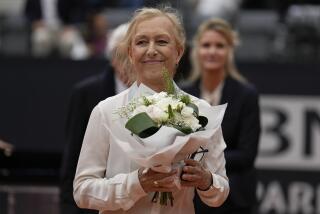Seles’ Second Half Starts at the Top : Tennis: Co-No. 1’s exhibition against Navratilova marks return from 1993 stabbing.
- Share via
ATLANTIC CITY, N.J. — Older and wiser in the ways of a dangerous world but still as enigmatic as ever, Monica Seles goes on public display today for the first time since she left a tennis court on a stretcher more than two years ago.
Seles elected to make her return to tennis as low-key as possible, in an exhibition against the recently retired and currently injured Martina Navratilova.
The best-of-three-sets match will be played indoors at the Atlantic City Convention Center, before a fawning crowd of 9,000. The exhibition’s inherent so-what result is the perfect vehicle for Seles’ comeback, after she was traumatically wrested from the game when she was stabbed in the back during a changeover in a match on April 30, 1993.
Although Seles, 21, is fully healed from the stabbing, there remain lingering questions about her mental fitness as well as her ability to withstand the rigors of the professional tour and the public exposure it engenders. Never one to tarry in the spotlight before she was attacked, Seles must endure its bright glare again.
Today’s match constitutes merely a return to the business of tennis, not the WTA tour. Seles has said that she intends to play in the U.S. Open late next month and had hoped to play in at least two earlier tournaments--the Toshiba Classic at La Costa, starting Monday, or the Acura Classic at Manhattan Beach, which begins Aug. 7. Tendinitis in her knees has caused Seles to rule out La Costa, but Manhattan Beach remains a possibility.
Navratilova is also in less than perfect shape. She aggravated a groin injury but expects to be fully healed by today.
Tennis fans will no doubt be curious about more than whether Seles still grunts and giggles or what color she has dyed her hair. They might wonder if she can recapture the form that allowed her to win seven of the last eight Grand Slam tournaments she entered before the attack.
Seles says she views this as the second half of her interrupted career.
“For me, the hardest is that after I won the Australian Open in ‘93, it was the first time I felt happy at No. 1--everything on and off the court and the things that come with it,” Seles said. “Then everything happened. I just feel that since I didn’t get a chance to play those Grand Slams, I was stopped at the peak. But that happens, and now I have a chance to play great tennis again and go back to something that I love to do.”
Thanks in large part to Navratilova, Seles returns to tennis ranked as co-No. 1 with Steffi Graf. Navratilova, who is president of the WTA Players Assn., argued mightily that Seles return with the same rank she had when she left. The players at first agreed with Navratilova’s proposal, then reneged on aspects of it in heated meetings at Wimbledon. Finally, all sides agreed to a short-term protection of her ranking.
If other aspects of Seles’ game are in question, at least her renowned competitiveness remains intact. Navratilova and others who have practiced with her marvel that Seles is hitting the ball harder than before and has improved her serve and added a volley.
Yet Seles acknowledges that hitting with her brother, Zoltan, and practicing with Navratilova on her back-yard courts does not replicate the atmosphere or level of play on the WTA tour.
“You can practice a lot, but when you play a match, it is a little bit different,” she said. “You have a huge crowd and the pressure of a match. No matter how much you practice, it is different. You’re much more nervous during a tournament. It is something I haven’t done in 2 1/2 years, but I am sure I can handle it. It was working for me before, and I’m going to try to get back to that.”
More to Read
Go beyond the scoreboard
Get the latest on L.A.'s teams in the daily Sports Report newsletter.
You may occasionally receive promotional content from the Los Angeles Times.











